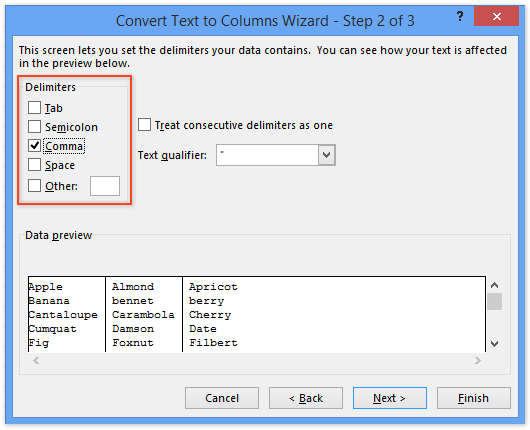Split text into different columns with functions
※ Download: Excel split string by comma
All contents Copyright 1998-2018 by MrExcel Publishing. The result is the ending position of the middle name. The text for us is held in the variable called txt.

The reason for choosing this character is that we know it does not occur in the original text. You'll also learn how to troubleshoot, trace errors, and fix problems. Well, that's where the Split function can help. User Alert System provided by - Copyright © 2018 DragonByte Technologies Ltd.

Split a String in Excel - And in the Specify a separator section, select the Other option, enter the comma symbol into the textbox, and then click the OK button.

Column1 contains values like: 10969 11284 1222 1227 12669 12670 12671 12672 Column2 contains comma separated values like this: 601010,6010,40,4010 601010,6010,40,4010 40,4010,6010,601010 40,4010,6010,601010 40,4010,6010,601010 40,4010,6010,601010 40,4010,6010,601010 40,4010,6010,601010 I need this split up differently, so instead of having column2 commaseparated, I need 1 row for each value i column 2 Column1 should use the same value for each string, so you get 4 rows with the same number in column1 and different numbers in column2 An example using the data from above Column1 10969 10969 10969 10969 11284 11284 11284 11284 Column2 601010 6010 40 4010 601010 6010 40 4010 It is not the same values everytime, and there is more than 1000 lines, so its a big task to do it manually. I hope someone can point me in the right direction. However, when I tested the code, it was sometimes not clear if the code had ran as you need to remember that Excel has a nice feature of adding commas for you to separate numerical values. For example, where you might have 123456,123456789 this code will split it but Excel might then display 123,456 and 123,456,789 as the results. You will need to amend your formatting so that this does not happen. This is a perfect fit for Power Query. Suck the table into Power Query, split Column2 with the comma delimiter, select all but the first columns and click Unpivot. I've tried to copy your data sample, but some rows come back as text with only numbers and commas, and other rows come back as very, very big numbers in exponential format. So you may need to do some work on defining the incoming data type. This may be an issue with regional settings. My regional settings have the comma as the thousand delimiter. You may be better off posting an actual Excel file with a file sharing service and post a link here. Power Query can do this -- that's a given. We just need to straighten out the data format to work out HOW to do it.
In the second Convert Text to Columns Wizard dialog box, only check the Comma box in the Delimiters section, and click the Next button. And then another prompt box will pop excel split string by comma to remind you select a cell to output the result, see screenshot: 4. The formula extracts nine characters, starting from the left. The limit is an integer and is used to restrict the number of pieces that Split produces. Offset I, 0xRg1. The formula you see on the left will be displayed for reference, while Excel will automatically convert the formula on the right into the appropriate result. In the Split Cells dialog box, select Split to Rows or Split to Columns in the Type section as you need. Binary 0 Binary comparison CompareMethod. The formula extracts six characters in A2, starting from the right. When finished proceed with Next Text to Columns Wizard: Step 2 Format your columns optional The last step is to format your columns if needed. The result is the ending position of the first name. To get at each position in the array we have a pair of round brackets after the array name.



